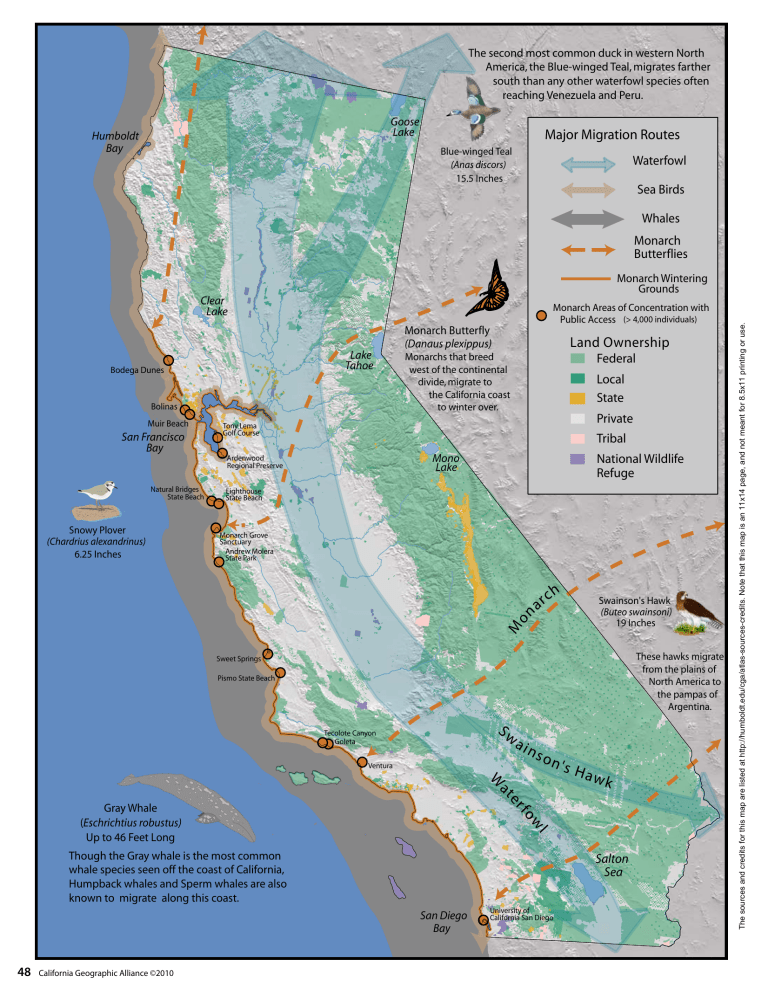
Major Animal Migration Routes
The second most common duck in western North
America, the Blue-winged Teal, migrates farther
south than any other waterfowl species often
reaching Venezuela and Peru.
Goose
Lake
Humboldt
Bay
Major Migration Routes
Blue-winged Teal
(Anas discors)
15.5 Inches
Waterfowl
Sea Birds
Whales
Monarch
Butterflies
Clear
Lake
Lake
Tahoe
Bodega Dunes
Bolinas
Muir Beach
San Francisco
Bay
Natural Bridges
State Beach
Monarch Butterfly
(Danaus plexippus)
Land Ownership
Federal
Monarchs that breed
west of the continental
divide, migrate to
the California coast
to winter over.
Local
State
Private
Tony Lema
Golf Course
Tribal
National Wildlife
Refuge
Mono
Lake
Ardenwood
Regional Preserve
Lighthouse
State Beach
Monarch Grove
Sanctuary
Andrew Molera
State Park
r
na
ch
M
o
Snowy Plover
(Chardrius alexandrinus)
6.25 Inches
Monarch Areas of Concentration with
Public Access (> 4,000 individuals)
Swainson's Hawk
(Buteo swainsoni)
19 Inches
These hawks migrate
from the plains of
North America to
the pampas of
Argentina.
Sweet Springs
Pismo State Beach
Sw
Tecolote Canyon
Goleta
Ventura
ain
W
son
at
er
fo
Gray Whale
(Eschrichtius robustus)
Up to 46 Feet Long
w
l
Though the Gray whale is the most common
whale species seen off the coast of California,
Humpback whales and Sperm whales are also
known to migrate along this coast.
Salton
Sea
San Diego
Bay
48
California Geographic Alliance ©2010
's H
awk
University of
California San Diego
The sources and credits for this map are listed at http://humboldt.edu/cga/atlas-sources-credits. Note that this map is an 11x14 page, and not meant for 8.5x11 printing or use.
Monarch Wintering
Grounds
Animal Migration (map on left page)
California’s diverse natural environments provide habitat
for more plant and animal species than any other state.
This remarkable biodiversity includes species of 5,418 plants,
415 birds, 195 mammals, 86 reptiles, 57 amphibians, and
62 freshwater fish. Their continued survival depends on a
complicated patchwork of private and government owned
land. While parks and reserves protect many species, humans
use much of California for housing, crops, and grazing. This
affects the habitats required for native plants and animals.
Migratory species spend part of each year in California, then
fly, walk, or swim elsewhere for the rest of the year. California’s
path of waterfowl and whale migrations between Arctic
Companion Website for California: A Changing State
summer feeding grounds and more southerly winter locations.
www.humboldt.edu/cga Birds and butterflies also travel between the Pacific Coast and
Downloadable Maps
Downloadable Images
interior North America. The map does not show the seasonal
Interactive Maps
Lesson Plans
movement of species within California, such as deer migrations
Expanded Glossary
Deconstructed Text
up and down mountain slopes in search of better food, and the
California Gull that winters on the coast, and then flies across
the Sierra Nevada to summer at Mono Lake.
The California Geographic Alliance promotes standards-based geographic education
among teachers, students, and the public. We help educators prepare students to
embrace a diverse world, succeed in a global economy, and steward the planet’s resources.
Sources
General References Used Throughout:
Atlas of California, 1979; American Heritage
Pictorial Atlas of US History, 1966; California
Water Atlas, 1979; California Patterns, 1983
Pages 4-5 Tom Patterson, Natural Earth II;
Environmental Systems Research Institute
Page 6 Oregon Geographic Alliance; Pacific
Coast Trail Association; USGS Lake Tahoe Data
Clearinghouse; USGS EarthExplorer
Page 7 Oregon Geographic Alliance;
Environmental Systems Research Institute
Page 8 Oregon Geographic Alliance
Page 9 Oregon Geographic Alliance
Page 10 Oregon Geographic Alliance; Atlas of
California, 1979; US Census Bureau, 2000;
Environmental Systems Research Institute
Page 11 California Geological Survey, California
Department of Conservation; UC Berkeley
Seismological Laboratory, Northern California
Earthquake Catalog; USGS Earthquake Hazards
Program-Northern California
Page 12 California Spatial Information Library;
USGS Digital Elevation Model
Page 18 National Climatic Data Center,
US Department of Commerce; USGS Digital
Elevation Model
Page 25 The Atlas of California, 1979; California
Spatial Information Library; Calisphere
Collections for Educators, University of California
Page 40 “Analysis of California Agricultural
Issues.” University of California Agricultural
Issues Center, 2009.
Page 20 Native Tribes of North America, Univ.
Calif. Publ. Am. Arch. and Ethn., Vol. 38, University
of California, 1939; Atlas of California, 1979;
California Patterns, 1983; California Indian
Libraries Collection, UC Berkeley
Page 26 Map of the Gold Regions of California,
Showing the Routes via Chagres and Panama,
Cape Horn, & c., 1849 (David Rumsey Map
Collection); Atlas of California, 1979; Tom
Patterson, Natural Earth II
Page 41 International Trade Administration,
US Department of Commerce; California
Technology, Trade, and Commerce Agency
Page 21 Native American Lands Today,
Geography Division, Cartographic Operations
Branch, U.S. Census Bureau, 2000
Page 27 Atlas of California, 1979
California Spatial Information Library
USGS Digital Elevation Model
Page 22-23 General references (above) and
Timeline Results for Spanish Missions, Google
Page 28 California: An Interpretive History, 2002;
California Spatial Information Library
Page 24 General: Exploration and Settlement
1820-1835, Perry-Castaneda Library Map
Collection, University of Texas Libraries; The
Search for a Southern Overland Route to
California, Harlan Hague, California Historical
Quarterly, Summer, 1976.
Page 29 AWIPS California Counties
Anza: The Web de Anza Project, Center for
Advanced Technology in Education, College
of Education, University of Oregon.
Page 30 California Spatial Information Library
Page 31 California Spatial Information Library;
US Fish and Wildlife Service
Page 32 Handbook of North American Indians,
Vol 8, 1978; J.T. Davis, 1974 (1961); Atlas of
California, 1979
Page 33 California Spatial Information Library
Ogden: Peter Skene Ogden’s Snake Country Journals
Page 34 The California Water Atlas, 1979
Page 13 National Land Cover Database, 2001
Portola: Gaspar de Portola, San Diego
Biographies, San Diego Historical Society
Page 35 California Department of Water Resources
Page 14 Commission for Environmental
Cooperation (CEC), 2010
Smith: Jedediah S. Smith, Utah History
Encyclopedia
Page 15 Atlas of California, 1979
Young: End of the Oregon Trail Interpretive Center
Pages 16-17, 19 PRISM - a cooperative product
between Spatial Climate Analysis Service and the
Oregon Climate Service, Oregon State University,
Corvallis. This product contains data from The
Climate Source and is used herein by permission,
Copyright (c) 2010. The Climate Source. All
Rights Reserved.
Fremont: Captain John Charles Fremont and the
Bear Flag Revolt, The California State Military
Museum, California State Military Department
Page 36 California Spatial Information Library;
The Atlas of California, 1979; The California Water
Atlas, 1979
Page 42 Homeland Security; Public Policy
Institute of California; Statistical Yearbook of
the Immigration and Naturalization Service;
State of California, Department of Finance;
State of California, Department of Finance, Legal
Immigration to California, 1984-1994: A Summary,
January 1997.
Page 43 US Census Bureau, 2000
Page 44 US Census Bureau, 2000
Page 45 US Census Bureau, 2000
Page 46-47 US Census Bureau, 2000;
Environmental Systems Research Institute
Page 48 US Fish and Wildlife Service;
California Spatial Information Library.
Page 50 California Community Colleges
Chancellor’s Office; The California State
University Map of Campus Locations;
University of California It starts here
Page 52 California as an Island: circa 1650,
Johannes Vingboons
Page 37 California Department of Water
Resources, and the California Water Atlas, 1979
California Trail: California National Historic
Trail, National Park Service, US Department
of the Interior
Page 38 Farmlands Mapping and Monitoring;
Program, California Department of Conservation;
California Department of Forestry and
Fire Protection; California Department of
Water Resources
Hudson Bay Company: Our History, Hudson
Bay Company
Page 39 California Department of Food
and Agriculture
California Geographic Alliance ©2010
The sources and credits for this map are listed at http://humboldt.edu/cga/atlas-sources-credits. Note that this map is an 11x14 page, and not meant for 8.5x11 printing or use.
mid-latitude location on the globe places it squarely on the
49







